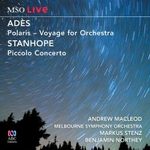Work
Concerto for piccolo flute and orchestra
by Paul Stanhope (2013)
Also known as: Piccolo concerto
Score Sample
This sample is from the Piccolo with full orchestra version of this work
Audio Sample
|
|
Performance by Melbourne Symphony Orchestra, Andrew Macleod, Benjamin Northey from the CD Polaris: voyage for orchestra, by Ades ; Piccolo Concerto, by Paul Stanhope |
Versions of this work
Select from the following versions of this work to view more detailed information:
Products featuring this work
| Format | Title | Version | AMC Library | Price | |
|---|---|---|---|---|---|
|
Score |
Concerto for piccolo flute : for piccolo and piano / Paul Stanhope. |
Piccolo with piano | Not for loan | $POA | |
|
CD |
Piccolo with full orchestra | Available for loan | Out of Print |
Work Overview
Despite the considerable public transport advantages of the instrument, the piccolo is, unfortunately, not blessed with a fulsome concerto repertoire. There are only a few baroque examples (which were really written for recorder) and a smattering of recent works. When Andrew Macleod, Principal Piccolo for the Melbourne Symphony Orchestra suggested I write him a concerto, I immediately thought it was a great idea. And having heard Andrew's playing, I was convinced of the overriding artistic merits, not just the practicality of adding to a small body of works.
The piccolo has, of course, the great advantage of being able to cut through loud orchestral textures, yet it also has many more possibilities not often explored in the orchestral repertoire.
This concerto is in two movements. The first movement is simply titled "Hymn". Throughout this movement I have used fragments of "Love Unknown" a hymn tune by English composer John Ireland. My own reason for using the hymn tune has more to do with its message of compassion and humanity rather than suggesting strict religious observance. Composed in a symmetrical form the hymn is used as a structural road-map and also the basis for motivic material. The movement falls somewhere in the cracks between a Chorale Prelude - which is a form found in organ works where a hymn tune is essentially embellished and considerably expanded - and a set of variations over a ground bass.
The movement begins in an understated and mostly lyrical fashion, before launching into a more dance-like, climactic section whereupon the musical argument becomes more diffuse. The section of the tune with the lyrics "love to the loveless shown" is given special importance in this central part of the piece with a short insistent motive which is then contradicted by other, more argumentative elements as though this "bleeding heart" notion is being interrogated by a shock jock. The contradictory music is jagged and spiky, coloured mainly by the upper woodwinds and tuned percussion. As the material is developed it becomes more abstract until an angry outburst seems to settle the score giving way to a return of the more optimistic sounding sections heard earlier, this time bursting into a clear-voiced enunciation of the compassion theme. An understated and slightly saddened version of John Ireland's hymn is stated in full for the first time at the end of the piece in the lower strings, climbing through the upper registers at last reaching the solo piccolo.
The second movement, Scherzo (which is Italian for 'joke' although in musical terms connotes a fast-moving, humorous piece) is subtitled "Wheels within Wheels" suggesting material that moves simultaneously at different speeds. The initials of "wheels within wheels" - www - also hints at the impact of the information age and the sense of overwhelming speed at which our digital world operates. Furthermore, the Old Testament book of Ezekiel makes mention of a vision of the divine throne and four heavenly creatures with chariots of wheels within wheels. Although religious overtones were not deliberately sought out, it is nice to know that you are on the same page as divine creatures.
Replete with twisting, turning solo piccolo passages over percussive orchestral textures, there are humorous interjections from the tuba, bass clarinet and contrabassoon (strange buddies indeed for the piccolo, but perhaps also the other instruments that didn't get invited to the concerto-prom) and also the otherworldly sounds of tuned cowbells.
This Scherzo is written in a kind of binary form, whereby the two halves of the movement are separated by an extended cadenza. Here the solo piccolo can really show its wares as an instrument capable of many surprises, including a number of surprisingly soft high notes and some lush low-register sounds. This launches the music towards a large dance-like climax before the wheels seem to briefly and dangerously jump out of their cogs. Fortunately the solo piccolo puts a stop to this nonsense and restores order for a brief final flourish.
Concerto for Piccolo Flute and Orchestra was commissioned by Symphony Services International for its premiere season by the Melbourne, Adelaide and Tasmanian Symphony Orchestras in June and July 2013.
Work Details
Year: 2013
Duration: 18 min.
Subjects
- In the form/style of: Concertos
Performances of this work
26 Jul 2013: at TSO: Marko Letonja & Hudson (Federation Concert Hall, Hobart). Featuring Marko Letonja, Tasmanian Symphony Orchestra, Lloyd Hudson.
22 Jun 2013: at ASO: Stanhope (Adelaide Town Hall). Featuring Rory Macdonald, Julia Grenfell, Adelaide Symphony Orchestra.
21 Jun 2013: at ASO: Stanhope (Adelaide Town Hall). Featuring Rory Macdonald, Adelaide Symphony Orchestra, Julia Grenfell.
20 Jun 2013: at ASO: Stanhope (Adelaide Town Hall). Featuring Julia Grenfell, Adelaide Symphony Orchestra, Rory Macdonald.
6 Jun 2013: at MSO: Copland, Stanhope, Stravinsky (Hamer Hall, Arts Centre Melbourne). Featuring Andrew Macleod, Melbourne Symphony Orchestra, Benjamin Northey.
Jun 13: Hamer Hall, Melbourne. Featuring Melbourne Symphony Orchestra, Andrew Macleod, Benjamin Northey.
User reviews
Be the first to share your thoughts, opinions and insights about this work.
To post a comment please login.

